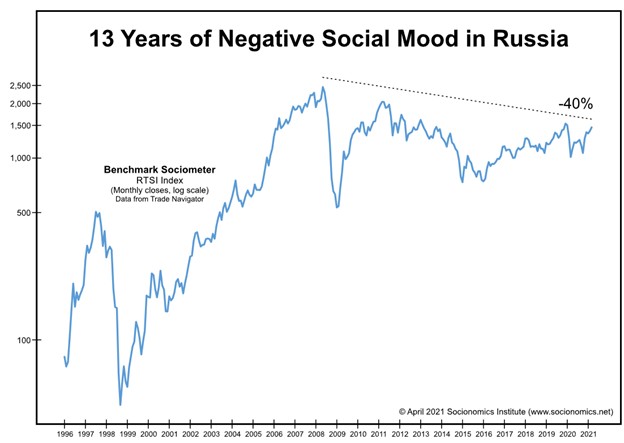Why the war continues to heat up instead of cooling down
The June 1 “Spiderweb” drone attack on strategic Russian airfields by Ukraine not only dashed any hopes of a ceasefire but also, was the proverbial slingshot between Goliath’s eyes. From AlJazeera on June 5:
The Spiderweb caught Russia’s military strategists off-guard because they had designed air defenses to thwart attacks by missiles or heavier, long-range strike drones.
Instead, the SBU used 117 toy-like first-person-view (FPV) drones, each costing just hundreds of dollars, that were hidden in wooden crates loaded onto trucks, it said.
Their unsuspecting drivers took them right next to the airfields – and were shocked to see them fly out and cause the damage that amounted to $7bn, the SBU said.
Our February 2012 Socionomist observed that, if negative social mood intensified (as reflected in a nation’s benchmark stock indexes)—asymmetrical warfare would likely occur, in which lesser-outfitted nations utilize unconventional weapons to fight back. From the February 2012 special report by researcher Alan Hall:
As animosity rises and military budgets fall, expect even more belligerence-on-the-cheap. Verbal threats, espionage, trade wars, financial conflicts, internal terrorism, cyber attacks, authoritarian clashes, border conflicts, drone attacks and anti-satellite attacks should all increase.
Training just one F-15 fighter pilot requires about 5000 hours and $10 million, yet an operator can learn to fly a medium-sized Hunter unmanned aerial vehicle (UAV) in 120 hours, and a smaller drone such as the Raven UAV in 60 minutes.
But when social mood shifts into another strongly negative phase… drones will become another flashpoint in the authoritarian/anti-authoritarian battle.
Specifically related to the conflict at hand, our May 2021 Socionomist predicted, using Russia’s bear market as a barometer for social mood, that a major conflict with Ukraine was imminent:
Elliott Wave International’s assessment of the Russian stock index’s price action indicates an elevated probability for a near-term acceleration to the downside, which would signal an intensification of negative mood in the country and a corresponding intensification in its negative mood expressions.
Russia’s shows of force in the Arctic and near the border with Ukraine must be understood in the context of the country’s negative mood trend. As it did in its invasion of Georgia and its annexation of Crimea, Russia is once again displaying a willingness to vent its negative mood through its military might.

Nine months later, in February 2022, Russia launched the military invasion of Ukraine as its stock market continued to plunge to 15-year lows in 2024.
The Russia-Ukraine conflict isn’t an isolated incident of escalating, geopolitical tensions. And, the insights from our February 2012 Socionomist special report “What Socionomics Says About the Timing of the Next World War” have never been more relevant. Purchase the single report today, for just $15!
